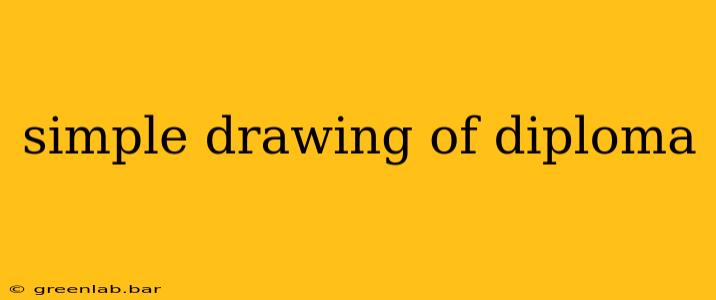Simple Drawing of a Diploma: A Step-by-Step Guide
Creating a simple drawing of a diploma is easier than you think! This guide will walk you through the process, perfect for anyone needing a quick visual, from students celebrating graduation to teachers creating classroom decorations. We’ll focus on capturing the essence of a diploma without getting bogged down in intricate details.
Materials You'll Need:
- Paper: Any type of paper will do, from sketchbook paper to printer paper.
- Pencil: A regular HB pencil is ideal for sketching.
- Eraser: To correct any mistakes.
- Optional: Colored pencils, markers, or crayons for adding color and vibrancy.
Step-by-Step Drawing Instructions:
-
The Basic Shape: Start by drawing a long, rectangular shape. This will be the main body of your diploma. Think of it as a slightly elongated rectangle, perhaps a bit wider at the bottom than the top, mimicking the slightly curved bottom edge of a real diploma.
-
The Fold (Optional): To make it look more realistic, you can lightly sketch a fold line down the middle of the rectangle. Don't press too hard; this line will likely be erased later or subtly integrated into the final design.
-
The Seal: A crucial element! Draw a circular shape near the top center of your rectangle. This represents the official seal or emblem often found on diplomas. Inside the circle, you can add a simple design, like a star, a simple geometric pattern, or even just leave it blank for a minimalist look.
-
Text Placeholders: Diplomas have text! To indicate this, lightly sketch rectangular boxes or lines within the diploma’s main body. These represent the areas where the recipient's name, degree, date, and institution would typically be written. Don't worry about writing actual words; the boxes suffice.
-
Embellishments (Optional): Add small details to enhance the visual appeal. Consider adding simple decorative elements like corner flourishes, a thin border around the edges, or a subtle shading to add depth. Keep it simple; less is often more when striving for a clean aesthetic.
-
Refining the Drawing: Once you're happy with the basic shapes, go over your lines with a slightly darker pencil stroke to make them more defined. Gently erase any unwanted guidelines or stray marks.
-
Adding Color (Optional): If you're using colored pencils, markers, or crayons, add color to enhance the visual appeal. A simple cream or off-white background with a darker colored seal and text boxes creates a classic look.
Tips for a Simple Yet Effective Drawing:
- Keep it simple: The goal is a simple drawing, not a hyperrealistic replica. Focus on the essential elements.
- Light pencil strokes: Use light strokes initially to allow for easy corrections.
- Don't be afraid to experiment: Try different shapes, sizes, and designs for the seal.
- Practice makes perfect: If your first attempt isn't perfect, don't worry! Keep practicing, and you'll quickly improve.
This simple guide provides a basic framework. Feel free to adapt it to your own artistic style and preferences. The most important thing is to have fun and let your creativity flow! Remember, a simple drawing of a diploma can be just as meaningful as a complex one.

